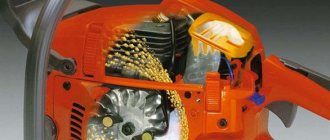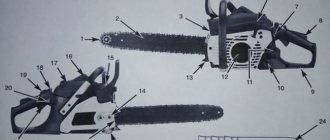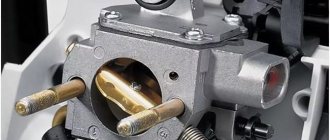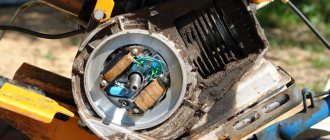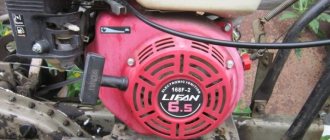MB-1 walk-behind tractor: operating instructions and do-it-yourself fault repair
Special equipment, such as a walk-behind tractor, is very useful in farming. Due to the fact that walk-behind tractors are maximally balanced in terms of price, cost and performance ratio, they benefit greatly from both tractors and other special equipment.
With its help, you can perform a large number of different operations that take a lot of time and require a lot of effort, using manpower and simple equipment. All areas where a walk-behind tractor can be used no longer evoke disgust and reluctance to work.
In fact, all the work comes down to management - you just need to be present as a driver.
This applies to both modern technology and older models of walk-behind tractors, because over the decades their design, in general, has changed little - weight has decreased, the variety of models has increased, and more advanced materials are used for manufacturing.
But the frame, engine placement and control method remained the same , the attachments, in fact, remained unchanged, the difference can only be external, in insignificant details.
Therefore, the good old walk-behind tractors, whose service life has already exceeded thirty years, are still in service, and do their job year after year. But every year they increasingly need repairs and replacement of parts and components.
After all, any equipment wears out and needs repair. And you should pay great attention to this if, for example, you make long trips with a loaded trailer. A seized hub won't be a big deal, but a malfunctioning part of a more complex part like the transmission will be frustrating, to say the least.
Therefore, you should familiarize yourself with all the “symptoms” of breakdowns in order to diagnose and prevent a malfunction in time.
Operating principle of a tractor magneto
Main elements of the device:
- generator;
- transformer;
- magnets.
Also includes a core, rotor, cam, ignition switch, capacitor and high-voltage cable. All parts are enclosed in a galvanized body.
The operating principle is based on the effect of electromagnetic induction:
- The transformer core ensures the closure of the power lines of the magnets.
- A magnetic flux appears.
- When the lines of a rotating magnet intersect with the turns of the transformer windings, the electromotive force becomes inductive.
Magneto functions - in power distribution
Device setup
There are many types of devices, differing in power, configuration method and other parameters. Let's look at how to adjust the magneto on the MTZ tractor. These tractors were usually equipped with the M 124-B1 device.
If a problem occurs, first of all you should check the gap between the breaker contacts. This is done using a special probe included in the tool kit. The mechanic slowly turns the crankshaft by the flywheel, observing the interval between contacts. At the moment when the distance is greatest, you need to check the gap by inserting a feeler gauge between the contacts. Then you should check the result with the numbers indicated in the instruction manual (they are different for each model). If there is a discrepancy, you need to loosen the screw securing the contact post and carefully turn the post itself inserted into the eccentric slot.
Owners of old tractors are often concerned with the question of how to set the magneto on the starter, or more precisely, set the ignition timing. On new tractors this parameter is set at the factory and does not require further adjustment. However, during operation there is often a need to install a new tractor magneto, which is not difficult to purchase. Or remove it, for example, when repairing the engine. After this, the device needs to be configured.
Magneto setup steps:
- remove the spark plug from the engine;
- through the resulting hole, turn the crankshaft clockwise until the piston hits top dead center;
- carefully turning the shaft back, set the piston 5-6 mm below this point;
- remove the magneto cover and turn the roller until the breaker contacts are open;
- ensure that the protrusions of the coupling half enter exactly into the grooves of the drive gear;
- secure the device with bolts, close the lid;
- Screw the spark plug into place.
Device
The MB 1 walk-behind tractor was very popular at one time , namely in the eighties and nineties of the last century.
At that time, the special equipment market, if it can be called such, was filled with the products of Soviet factories, among whose products the Lucha equipment was considered one of the best of its kind. The Luch MB 1 walk-behind tractor confidently competed with the similar Niva walk-behind tractor.
It regularly performed its main function - cultivating a field or garden, transporting goods: crops, firewood, building materials. It was then that the spread of homemade trailers began, and the trend towards turning these walk-behind tractors into mini tractors became established.
Although the technical characteristics of the "Luch" MB 1 are in many ways inferior to modern walk-behind tractors, during the peak of its distribution they were at their best - the mass of the assembled device is equal to one hundred kilograms, the speed is from 3.6 to 9 kilometers per hour, on a flat road, loaded , it consistently produces 8-99 kilometers per hour.
Acceleration to hundreds is, in principle, possible, but only under very specific conditions, which hardly anyone has recreated. Fuel consumption is 1.5-2 liters per hour , the fuel tank volume is 3.6 liters, so experienced drivers always have a canister of fuel in reserve.
Its big advantage is that the engine does not require constant filling of oil - timely maintenance, if necessary, is sufficient. The walk-behind tractor is quite easy to operate - this process does not require much physical effort.
The minimum space required for a turn has a radius of only 1100 millimeters. The movement of the walk-behind tractor is smooth, thanks to the chain gearbox with V-belt transmission, gear shifting occurs smoothly, without jerking.
For more information about the Luch MB1 walk-behind tractor, watch the video:
The transmission of the walk-behind tractor is quite reliable, has two forward and two reverse gears, and the engine is quite powerful for such a product - 5 horsepower, provides good traction and stable speed. High cross-country ability and soil traction are achieved due to pneumatic tires with large tread.
MB 1 is also convenient for transportation thanks to the quick-release steering wheel and wheels. As for possible problems, the occurrence of which is inevitable during the operation of any equipment, especially those manufactured during the times of the Soviet Union, repairing the Luch walk-behind tractor will not become a serious problem.
Over all the years that farmers, summer residents and farm owners have been using it, a large amount of information has accumulated regarding fast, inexpensive and reliable repairs. Thanks to the experience of its owners, who have found all the causes of problems, you can repair your Luch walk-behind tractor at no extra cost.
Malfunctions , no matter how serious they may seem, can be eliminated in a home workshop, using the most common tools, without resorting to the help of specialists. The only thing that is required of you is to diagnose the breakdown as accurately as possible, and then it’s a matter of little things.
How does a magneto work?
The device diagram will have the following description:
- Opposite the magnetic core shoes are the pole pieces from the rotor.
- The transformer core causes the power lines from the magnets to begin to close.
- When the magnet is in a 90-degree position during rotation, the main element becomes the gap between the tips and shoes.
- It is imperative that the lines of the magnet intersect with the turns of the windings of the transformer. Due to this, the electromotive force acquires induction. Ignition is also used in the processes.
The magneto distributes the current,
the emf acts on the device so that when closed contacts are used, a magnetic flux appears at the transformer core. As a result of opening the circuit, the current disappears from its primary type. Because of this, the magnetic field is sharply reduced.
Induction of EMF up to 25,000 Volts occurs when using a secondary winding. Self-induction of EMF up to 300 V will appear only if you open the contacts from the primary winding. The primary type circuit produces a self-inductive tone, which causes the magnetic current to disappear more slowly. Such situations are characterized by a decrease in the EMF for the secondary circuit.
Parts often begin to burn when sparks appear at the contacts. Connecting a capacitor to the structure is carried out in order to avoid such consequences. Then there is no spark between the contacts in the magneto, which is described above.
The rotor can be easily rotated to a 90 degree position. Afterwards the primary circuit is opened with a breaker. This moment is called the magneto outline.
Device diagram
The location of the transformer part inside the magneto on the tractor is characteristic. The part is pressed onto the shaft, helping to create a high voltage current. Another important part of the design is the rotor, which constantly performs the function of a permanent magnet rotating on two bearings. The cam is attached to the front of the rotor shaft. On the back there is a so-called leash. How each part works is easy to understand.
Be sure to read: How to make a lift in the garage with your own hands
When the magneto device is mounted on the engine, the wire is supposed to fit into the groove of the gear. The case is closed with a corresponding cover, which is used as a base for installing contacts from the breaker and terminals at the transformer windings. The breaker itself is also closed with an easily removable lid.
The primary winding must be connected to a moving contact that is insulated from the housing. The other end is connected to the contact, which remains motionless. The secondary winding must also be connected to the secondary winding at one of the ends. The spark plug works on a central electrode that connects to the other end. The side electrode of the spark plug is also connected to the magneto and starter housing.
Magneto setting
Each device has its own operating characteristics. They must be taken into account when setting up the mechanism.
For walk-behind tractors
When walk-behind tractors must operate uninterruptedly, the use of tractor magnetos will be the optimal solution. M-151 or M-137A are acceptable device options that can be installed in any conditions. Installation is carried out on the engine using flange connections. It is enough to use three small pins.
M-151 is a two-disc variety that contains the following components:
- Start accelerator.
- Housing supplied with distributor.
- Breaker plate.
- Transformer part.
- Roof.
- The part with the rotor.
- Frame.
Sufficient speed is transmitted to the rotor thanks to the starting accelerator. For this purpose, separate impulses are used. Starting and constantly rotating the engine results in a strong spark.
Such a device allows us to solve the problem associated with the fragility of the battery part with which walk-behind tractors are supplied. If you buy special adapters in advance, it will be easier to turn your idea into reality. The design is created independently or ordered by contacting specialized workshops. The adapter is created using autogen. Steel sheets with a diameter of up to 230 mm are used. The principle of operation does not change because of this.
In the case of MTZ tractors
M 124-B1 is a type of device that usually complements tractors. The magneto rotates to the right, 27 degrees being the angle at which the ignition is advanced. The PD-10 starter coupling half sets the mechanism in motion.
A two-contact magneto, along with any variety, includes the following components:
- Transformer.
- Intermittent.
- Rotary.
The rotor part is involved in the creation of alternating current. The energy is then sent to a transformer to raise the voltage to its maximum level. One of the last stages is the transfer of current to the breaker. Because of this, strength decreases. The magnetic current decreases. A spark discharge is created in the electrodes of the spark plugs, and the hot mixture is supplied with appropriate ignition. It's easy to figure out how to adjust the device.
Be sure to read: Technical characteristics of the D-242 engine
Repair instructions
In order to restore a faulty walk-behind tractor "Luch" MB 1, the repair instructions will definitely not be superfluous. By instruction we mean the same booklet that was supplied with all equipment produced in Russian factories.
But, as you know, without experience it’s quite difficult to figure out what’s broken, not to mention the design of the walk-behind tractor itself. But a person who is experienced in repeated repairs will be able to identify the problem without wasting time and also quickly fix it.
A good example of the level of knowledge and how well a person navigates a given walk-behind tractor is the reason why fire occurs from the exhaust pipe. The reason could be very simple - a defect associated with partitions in the muffler, which could burn out or simply fall off.
If the walk-behind tractors "Luch" MB 1, Cayman, Patriot, Texas, Foreman, Crosser, Viking, Forza do not start , then there may be more than enough reasons for the problem, starting from the presence of gasoline in the tank before it enters the carburetor, or if the belts are not in order or there are problems with their size...
In the first case, it is necessary to carry out simple manipulations: you need to fill the float chamber until the fuel begins to pour out from the hole in the lid. Or, check how gasoline flows by disconnecting the fuel hose from the carburetor.
A thin stream means that one of the filters is clogged - the fuel filter inside the tank, or the air filter in its lid. In this case, to restore operation it is enough to clean them, or, in extreme cases, replace them. But if you have any ignition problems, you should still check the spark plugs.
Adjusting the ignition system
How to set the ignition on a Neva walk-behind tractor depends on a number of factors. Nuances:
- model and availability of modernization;
- type of candles;
- setting time, that is, primary or secondary adjustment.
The initial setup is done together with the first run-in of the walk-behind tractor. The secondary one is carried out after any long work processes or downtime.
Before adjusting the ignition, you will need to run-in the walk-behind tractor and also check all other equipment systems.
Important! The ignition of the spark at the moment of ignition is regulated by distribution using the magneto cover, and the lower part of the mechanism interrupts it. For this function to work correctly, configuration and adjustment are required.
In this video you will learn about spark plugs for the Neva walk-behind tractor: When preparing the unit for working condition, how to check the ignition coil:
- the flywheel operating process is initially checked up to the point of contact opening occurring in the magneto;
- the distance between two parts of the system - the “anvil” and the “hammer” is measured;
- turning the flywheel until the piston mechanism is compressed;
- when the flywheel moves to the top, it is turned again. Next, a one-time knock will be heard, which indicates the operation of the overrunning clutch;
- the flywheel turns counterclockwise. The second mark should align with the body mark;
- the distance between the two contacts (cam and breaker) is adjusted. Each model has its own gap. For the Neva, the variation is from 0.25 to 0.35 mm;
- the cam is secured with a special type of screw located at the top.
Important! The standard procedure for setting the ignition is a mandatory procedure for the Neva.
Checking and repairing ignition coils is a mandatory procedure, since after adjustment, engine starting becomes faster and smoother. This leads to slow wear of the piston system group and other engine mechanisms.
These spark plugs fit the Neva walk-behind tractor
MB 1 is the predecessor of the Neva and the same type of ignition option.
Important! Spark plug failure is the most common failure, so it is necessary to have a spare spark plug that has been tested.
All settings and adjustments of the ignition of the walk-behind tractor are carried out only on proven spark plugs that have already been in use.
For engines of type DM 1 or modifications, the list of the most suitable spark plugs includes:
All these options have a thread size of 1.2 centimeters.
It is worth considering that profile candles from various well-known brands are well suited. For example, B8AC.
Saving on candles in the presence of MB class equipment is unacceptable. The same applies to modifications like NEVA.
Checking the performance of the spark plug:
- the candle is turned out;
- wiping the electrodes with a dry cloth;
- removing carbon deposits if present;
- the gap is established between the electrodes;
- a square from a high-voltage wire is attached to the spark plug;
- the spark plug body is pressed against the head of the cylinder;
- Then the crankshaft is turned and it looks to see if there is a spark.
In this way you can check any type of candle.
Important! The clearance size between the starter system and the magnetic shoe is from 0.1 to 0.15 mm.
If the gap is of a different size, it will need to be adjusted. It is worth remembering that each type of walk-behind tractor has its own gap size, but for MB modifications it is located in the range of 0.1-0.15.
Don't forget about the gap
Neva-type equipment differs from similar walk-behind tractors in increased wear resistance and efficiency, but it is necessary to check the ignition coil on the walk-behind tractor before starting work.
The ignition coil is adjusted in the standard way:
- A landscape sheet of A4 format is folded into four;
- two bolts on the module mounting are loosened;
- a folded sheet is placed under the pillow;
- the pillow is pressed through, the fastening bolts are tightened;
- the flywheel rotates;
- check for spark;
- the mechanism is fully installed.
If the cultivator undergoes a major overhaul or any replacement of parts, then the ignition of the MB walk-behind tractor is also checked.
According to clearance checks for MB and further modifications, including the new Neva model range, there are differences in the size of the required clearance. Most of it is set in the operating instructions, which are individual for different types of models.
Improving the ignition in the Mole walk-behind tractor with your own hands
Now you can buy any equipment in earthworks stores, but many farms use walk-behind tractors and motor-cultivators from the stagnation era.
Some owners have been using Mole walk-behind tractors for 20 years and suddenly there is a breakdown - the MB-1 electronic ignition unit has failed.
Although there is a proven option with light motorcycles and mopeds - a generator coil, electronic filling and an ignition coil - there are no separate components and no problems in the ignition system.
And in MB-1, the winding of the generator coil is made with very thin wiring and the ignition coil is small, and most importantly, the electronic part of the circuit is located on the engine crankcase and heats up to 80 degrees. And the KU202N thyristor used in the circuit is designed for 75 degrees. That's why there are constant malfunctions. The same thyristors were used in ignition circuits used on light motorcycles and mopeds and worked reliably. The thin winding wire of the generator coil does not allow generating more current and installing a storage capacitor of 1 µF.
Try to separate these ignition elements. I’ll give you an example of how a friend from the forum improved the ignition unit.
The rest of the story will be told from his perspective:
— The ignition coil is automotive, with a multiple reserve and a spark twice as powerful as the previous one.
After all the modifications - repeated ignition reliability. Military-grade T 122-25-8 thyristor, thousand-volt diode bridge, eternal ignition coil.
Electrical ignition circuit:
Modernization of the ignition system (MB-1) of the Krot motor cultivator
Greetings to all! I would like to talk about the modification of the Mole ignition system, which allowed me to get rid of all problems with ignition reliability, and subsequently made it much easier to start the engine. I have never seen such a modification on the pages of this forum, or in other places either, and I hope that the work I have done will be useful to someone. First things first. I made the first alteration back in 2011. The message was simple. The main problem with the MB-1 magneto, in my humble opinion, is its miniature size (as well as one flaw in the circuit). If the designers had immediately followed the path known from light motorcycles - they would have separated the generator coils, the electronic circuit and the ignition coil into different units, then there would have been no problems with the ignition. And then it turned out that the generator coil is wound with a very thin wire, and the ignition coil is too small, and most importantly, the electronic circuit is installed directly on the engine crankcase and easily heats up to 70-80 degrees. But the KU202N thyristor used in the magneto is designed for a temperature of 75 degrees. As a result, it often fails. After all, the same thyristor was used in many motorcycles and mopeds and nothing worked. The thin wire of the generator coil winding did not make it possible to develop a large current and install a storage capacitor of at least 1 µF, and how to add a zener diode in motorcycles to cut off excess voltage. In general, the idea was born a long time ago to separate all three ignition elements. I immediately decided to use a car reel, which has multiple reserves. Then, with a large car coil, the spark with the same circuit turned out to be at least three times more powerful. And then a Toyota car coil with a switch turned up very successfully. The switch burned out and I just installed my own circuit in its place. Attaching photo. The coil was installed on a plate on the steering wheel. The high-voltage wire is standard, automotive. From the original MB-1 I left only the generator coil and the sensor coil. I wired them out, and decided to use a shielded one for the sensor. In principle, everything is clear from the photo, but if you have any questions, I’ll explain. I will give a description of the circuit and the circuit itself a little later. But that's not all, the whole tsimus is ahead.
So here it is. What happened after the first rework was enormous reliability. Military thyristor T122-25-8, 1000 volt diode bridge, monumental ignition coil. There are no more weak points. The previous owner replaced 6 MB-1 over 10 years of operation. And now it won’t break. But there was also a reason to be sad. The circuit that worked perfectly on the table, giving such a spark that it would stop an elephant, wilted somewhat on the engine. The spark power has dropped. After some time it became clear what was going on. The reason for this is the generator coil. Very thin wire and many turns. Only the DC resistance is about 3 kOhm. But during rotation, inductive reactance is also added. As a result, as the speed increases, the voltage decreases. And instead of at least a fourfold increase in spark power, it turned out to be twofold (all by ear, by eye, approximately). In air the spark lasted up to 15 mm. This scheme did not bring very significant improvements in starting properties (although a warmed-up engine could be started if you strongly pushed the flywheel towards you with your palm). That is, the frequency of spark formation has decreased significantly - almost like on a tractor magneto, a spark began to strike when rotated by hand. But the main problem remained - the problem of hot starting, which always tormented me on my Mole. For 4 years this scheme served me faithfully. I kept wanting to play with the generator coil. Try searching with less resistance. But somehow I didn’t get around to it. And last fall I was struck by an idea that transformed the character of the engine. Twisting the magneto in my hands, I realized that I could try installing a second generator coil in the vacant space of the ignition coil. I had to work with a file, grind off part of the magnetic circuit of the coil and the seat on the magneto. But in the end everything worked out. Since the Mole has a flywheel with 4 magnets, one of which is upside down, I decided not to bother with the phrasing of the windings and installed my own diode bridge on each coil. This is what happened.
Battery ignition instead of magneto
Four years ago I purchased a used mini-tractor AMZHK-8.
It is equipped with a four-stroke two-cylinder carburetor engine SK-12-20 with an ignition system from a contactless left-hand rotation magneto 13.3728 with two sockets for high-voltage wires. An old decommissioned M-149A double-spark contact magneto of left-hand rotation turned up. After thinking a little, I removed the transformer, the distribution rotor (runner) and the coal from the distributor cover from the housing. What remains is a movable and fixed plate with a breaker and a capacitor.
The cam is pressed onto the almost assembled body and secured with a screw from the end of the roller, taking into account the ignition timing. I took the ignition coil from a Dnepr motorcycle. The B-204 coil has two high-voltage terminals. I placed it in a suitable plastic box in the place of least heat from the engine.
The wiring was done according to the motorcycle battery ignition circuit. The ignition is adjusted by turning the magneto housing in the mounting socket and turning the movable breaker plate.
The system has been working flawlessly for three years. The only condition is the presence of a battery.
Prices / Order
500 rubles
Firms
If you are interested in high-quality repair of chainsaws in Moscow, the service center has created optimal conditions for eliminating all possible problems. We know that gas chain tools require more maintenance than other garden equipment.
There are several reasons for this. Firstly: dirty working conditions. Secondly: the high loads that chainsaws experience. Third: irregular use after long-term storage. Proper maintenance and timely repair of a chainsaw is a guarantee of a long service life of the equipment and maintaining its efficiency.
We provide a full range of services for the maintenance and repair of chainsaws:
Sharpening the chain A sharpened chain has a decisive influence on the quality of the chainsaw. A saw with a dull chain will burn rather than cut through the wood. The saw chain tends to become dull easily when in contact with stones, metal or soil. Professional saw sharpening is the best way out. Only a professional can sharpen all the teeth evenly so that the saw does not lose efficiency.
Chain tension Saw chains can stretch during use. A loose chain may break during operation. To ensure safe operation of the chainsaw, you should regularly check the chain tension at a service center.
Lubrication Modern saws are designed with automatic lubrication. If this is not the case in your case, you will need to add oil every time you refuel. Due to lack of oil, the saw set may fail. After starting the saw, it is necessary to check the operation of the lubrication system: if the system is working correctly, oil splashes should be visible on the surface of the saw.
Safety equipment To ensure safe operation of the chainsaw, it is necessary to periodically check the proper operation of the chain brake. The chain should stop at idle speed; if this does not happen, the centrifugal clutch must be serviced.
Fuel Oil and gasoline must be mixed in a certain proportion. If the proportion is violated, the chainsaw engine can quickly fail. If you expect to use up gasoline within a month, it is worth adding a stabilizing additive to it.
Maintenance Required engine maintenance includes such procedures as regular cleaning and replacement of the air filter, cleaning and replacement of the spark arrester, cleaning of the engine cooling fins, and replacement of the spark plug. In some cases, carburetor adjustment may be necessary.
DOMOSTROYPlumbing and construction
- Thursday, December 12, 2022 1:06
- Author: Sereg985
- Comment
- Category: Construction
- Link to post
- https://firmmy.ru/
Now you can buy any equipment in earthworks stores, but many farms use walk-behind tractors and motor-cultivators from the stagnation era.
Some owners have been using Mole walk-behind tractors for 20 years and suddenly there is a breakdown - the MB-1 electronic ignition unit has failed.
Although there is a proven option with light motorcycles and mopeds - a generator coil, electronic filling and an ignition coil - there are no separate components and problems in the ignition system.
